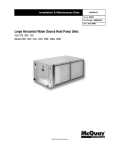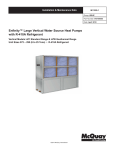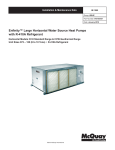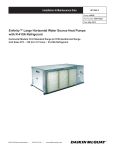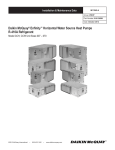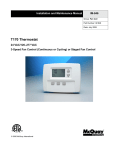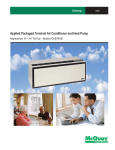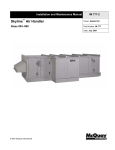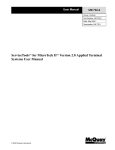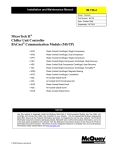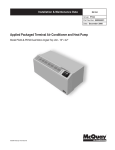Download McQuay LIA266 Specifications
Transcript
Installation & Operation Manual Auto-changeover Electronic Thermostat LIA266 Group: WSHP Supercedes: LIA204-4 Date: May 2007 2 Heat/2 Cool, Auto or Manual Changeover, Hardwired Part No. 668375401 ● ● ● ● ● ● ● ● Configurable Two Stage Heat / 2 Stage Cool Systems Backlit Display Field Temperature Calibration Status Indicator Light Relay Outputs (minimum voltage drop in thermostat) Night Set-Back Override Reset For replacement parts call 1-800-377-2787 ©2008 McQuay International • www.mcquay.com • 800-432-1342 Table of Contents Parts Diagram..............................................................................................................................1 Specifications...............................................................................................................................2 Important Safety Information......................................................................................................2 Package Contents/Tools Required................................................................................................2 To Remove Existing Thermostat.................................................................................................3 To Install Thermostat...................................................................................................................3 Remote Sensor Installation (Optional).........................................................................................5 Terminal Designator Descriptions................................................................................................6 Wiring Diagrams...........................................................................................................................6 Configuration Mode......................................................................................................................8 Testing the Thermostat.............................................................................................................11 Mode of Operation.....................................................................................................................12 Operating Modes.......................................................................................................................13 Troubleshooting.........................................................................................................................14 Factory Default Settings............................................................................................................15 Parts Diagram S1 668375401 S2 W1 Y1 W2 Y2 O R12 Specifications Electrical rating: •24 VAC/VDC (18-30 VAC/VDC) • 4 amp maximum total load •1 amp maximum per terminal Temperature control range: 45°F to 90°F (7°C to 32°C) Accuracy: ± 1°F (± 0.5°C) System configurations: 2-stage heat, 2-stage cool Timing:Backlight Operation: 13 seconds after mode change or button press Terminations: -C, +R, W1, Y1, W2, Y2, G, O, S1, S2 Important Safety Information WARNING!: Always turn off power at the main power supply before installing, cleaning, or removing thermostat. •This thermostat is for 24 VAC/VDC applications only; do not use on voltages over 30 VAC/VDC •Do not short across terminals of system control to test operation; this will damage your thermostat and void your warranty •All wiring must conform to local and national electrical and building codes •Use this thermostat only as described in this manual Package Contents/Tools Required Package includes:Thermostat on base, thermostat cover, wiring labels, screws and wall anchors, Installation, Operation and Application Guide Tools required for installation: Drill with 3/16” bit, hammer, screwdriver To Remove Existing Thermostat ELECTRICAL SHOCK HAZARD – Turn off power at the main service panel by removing the fuse or switching the appropriate circuit breaker to the OFF position before removing the existing thermostat. 1. Turn off power to the heating and cooling system by removing the fuse or switching the appropriate circuit breaker off. 2. Remove cover of old thermostat. This should expose the wires. 3. Label the existing wires with the enclosed wire labels before removing wires. 4. After labeling wires, remove wires from wire terminals. 5. Remove existing thermostat base from wall. 6. Refer to the following section for instructions on how to install this thermostat. To Install Thermostat ELECTRICAL SHOCK HAZARD – Turn off power at the main service panel by removing the fuse or switching the appropriate circuit breaker to the OFF position before removing the existing thermostat. IMPORTANT: Thermostat installation must conform to local and national building and electrical codes and ordinances. Note: Mount the thermostat about five feet above the floor. Do not mount the thermostat on an outside wall, in direct sunlight, behind a door, or in an area affected by a vent or duct. 1. Turn off power to the heating and cooling system by removing the fuse or switching the appropriate circuit breaker off. To Install Thermostat (continued) 2. To remove cover, insert and twist a coin or screwdriver in the slots on the sides of the thermostat. 3. Put thermostat base against the wall where you plan to mount it (Be sure wires will feed through the wire opening in the base of the thermostat). 4. Mark the placement of the mounting holes. 5. Set thermostat base and cover away from working area. 6. Using a 3/16” drill bit, drill holes in the places you have marked for mounting. 7. Use a hammer to tap supplied anchors in mounting holes. 8. Align thermostat base with mounting holes and feed the control wires through wire opening. 9. Use supplied screws to mount thermostat base to wall. 10. Insert stripped, labeled wires in matching wire terminals. See “Wiring Diagrams” section of this manual (Pages 6-7). CAUTION!: Be sure exposed portion of wires does not touch other wires. 11. Tighten screws on terminal block. Gently tug wire to be sure of proper connection. Double check that each wire is connected to the proper terminal. 12. Seal hole for wires behind thermostat with non-flammable insulation or putty. 13. Replace cover on thermostat by snapping it in place. 14. Turn on power to the system at the main service panel. 15. Test thermostat operation as described in “Testing the Thermostat” (Page 11). Remote Sensor Installation (Optional) Requires McQuay Remote Sensor Part Number 667720401 1.Remove cover from remote sensor housing. 2.Select an appropriate location for mounting the remote sensor. 3.Mount remote sensor unit using hardware provided. 4.Install two strand shielded wire between remote sensor and thermostat. Shielded wire must be used. Do not run remote sensor wire in conduit with other wires. • Wire 1 should run between the S1 terminal on the thermostat and the S1 terminal on the remote sensor • Wire 2 should run between the S2 terminal on the thermostat and the S2 terminal on the remote sensor • Connect the shielding of the wire to the S2 terminal on the thermostat 5.Disable the main sensor (R12) on the thermostat by cutting it from the circuit board. Terminal Designator Descriptions -C–24 VAC/VDC common +R–24 VAC/VDC hot W1–1st stage heat Y1–1st stage cool W2–2nd stage heat Y2–2nd stage cooling G–Fan O–Override Wiring Diagrams McQUAY SINGLE CIRCUIT ELECTRONIC THERMOSTAT O W G W Y F E L U A P V + 2 1 1 R C Mark IV Board Low Voltage Terminal Board -C +R W1 Y1 W2 Y2 Override (Optional) G O Mark IV Board Circuit 1 Low Voltage Terminal Board O W G W Y F E L U A P V + 2 1 1 R C Mark IV Board Circuit 2 Low Voltage Terminal Board O W G W Y F E L U A P V + 2 1 1 R C McQUAY DUAL CIRCUIT -C +R W1 Y1 W2 Y2 ELECTRONIC THERMOSTAT G O Override (Optional) Configuration Mode The configuration mode is used to set the McQuay Auto-changeover Electronic Thermostat to match your heating/cooling system. To configure the McQuay Auto-changeover Electronic Thermostat, perform the following steps: 1. Remove the cover of the thermostat by gently pulling on one of the corners. 2. Simultaneously hold the SW5 and SW6 buttons in for 5 seconds while the McQuay Auto-changeover Electronic Thermostat is in OFF mode. 3. Press the or button to change settings within each screen. 4. Press the SW6 button to advance to the next screen. Note: The SW5 button will return you to the previous screen. 5. To exit configuration mode, slide the Mode switch to Heat or Cool. Configuration Mode Settings The setup screens for Configuration Mode are as follows: 1. Heat Pump and Non Heat Pump – Press the or button to configure as heat pump, or non-heat pump system. Set to “O” for all McQuay WSHP, PTAC, PTHP and UV units. Press the SW6 button to advance to the next screen. 2. Heat Source – Set to “g”. Press the or button to set to “g”. Press the SW6 button to advance to the next screen. SET ROOM REMOTE DIFF FILTER SET ROOM REMOTE DIFF FILTER 3. Temperature Scale (F or C) – Choose Fahrenheit or Celsius. Press the or button to select. Press the SW6 button to advance to the next screen. SET ROOM DIFF FILTER REMOTE 4. 1st Stage Temperature Differential (1°F to 3°F) (0.5°C to 1.5°C) Set the number of degrees between your “setpoint” temperature and your “turn on” temperature. Press the or button to set differential value. Press the SW6 button to advance to the next screen. 5. 2nd Stage Temperature Differential (1°F to 6°F) (0.5°C to 3.0°C) Set the number of degrees between when stage 1 turns on and when stage 2 turns on. Press the or button to set differential value. Press the SW6 button to advance to the next screen. 6. Minimum Deadband (2°F to 9°F) (1.0°C to 4.5°C) Set the minimum separation between heat setpoint and cool setpoint in Auto Changeover Mode. Press the or button to set deadband. Press the SW6 button to advance to the next screen. 7. Staged Off Outputs Select whether the outputs for heating and cooling are staged off independently or are satisfied simultaneously. 1 = outputs staged off independently 0 = outputs off simultaneously Press the or button to set deadband. Press the SW6 button to advance to the next screen. 8. Minimum Cool Setpoint (45°F to 75°F) (7°C to 24.0°C) Adjust to control the minimum Cool set temperature allowed. Press the or button to select. Press the SW6 button to advance to the next screen. SET ROOM REMOTE DIFF FILTER SET ROOM REMOTE SET ROOM REMOTE DIFF FILTER REMOTE DIFF FILTER SET ROOM REMOTE DIFF FILTER DIFF FILTER SET ROOM SET ROOM SET ROOM REMOTE DIFF FILTER REMOTE DIFF FILTER SET ROOM DIFF FILTER REMOTE SET ROOM REMOTE DIFF FILTER 9. Maximum Heat Setpoint (55°F to 90°F) (13°C to 32°C) Adjust to control the maximum Heat set temperature allowed. Press the or button to select. Press the SW6 button to advance to the next screen. SET ROOM DIFF FILTER REMOTE SET ROOM DIFF FILTER 10. Room temperature offset (+9°F to -9°F) (+4.5°C to -4.5°C) Adjust to calibrate displayed room temperature to match actual room temperature. Note: When not set to 0, ROOM will display Press the or button to select. Press the SW6 button to advance to the next screen. SET ROOM 11. Maximum compressor cycles allowed per hour (-, 2-6) - = as many as needed, and 2-6 = maximum cycles/hour Press the or button to select. Press the SW6 button to advance to the next screen. SET ROOM 12. Status Indicator Light (Lt 0, 1, 2) 0 = Status indicator never on 1 = Status indicator on with first stage 2 = Status indicator on with second stage Press the or button to select. Note: Red light indicates heating cycle and green light indicates cooling cycle. Slide the Mode switch to Heat or Cool to exit configuration. 10 REMOTE REMOTE DIFF FILTER REMOTE DIFF FILTER SET ROOM DIFF FILTER REMOTE Testing the Thermostat Once the thermostat is installed, it should be thoroughly tested. CAUTION!: Do not energize the air conditioning system when the outdoor temperature is below 50 degrees. It can result in equipment damage or personal injury. Cool Test 1. Slide Mode switch to Cool mode. 2. Adjust set temperature so it is 5 degrees below room temperature. 3. Air conditioning should come on within a few seconds. Status indicator may come on. 4. Adjust the set temperature 2 degrees above the room temperature and the A/C should turn off. There may be a fan delay on your system. Cool Off Heat Auto Heat Test 1. Slide Mode switch to Heat mode. 2. Adjust the set temperature so it is 5 degrees above the room temperature. 3. Heat should come on within a few seconds. Status indicator may come on. 4. Adjust the set temperature so it is 2 degrees below the room temperature and the heat should turn off. There may be a fan delay on your system. Cool Off Heat Auto Fan Test 1. Slide Fan switch to On position. 2. Indoor fan turns on. 3. Slide Fan switch to Auto position. 4. Indoor fan turns off. Auto On Auto On 11 Mode of Operation The McQuay Auto-changeover Electronic Thermostat is a two-stage heat, two-stage cool thermostat. The thermostat activates the first stage of heating when the room temperature is below the heat set temperature (by the differential temperature). The second stage of heating will be activated if the room temperature continues to drop. The heat outputs are staged off (configurable, setting 7, Page 9) as the room temperature increases. When the room temperature is greater than the cool set temperature (by the differential temperature), the cooling device is activated. The second stage of cooling will be activated if the room temperature continues to rise. The cool outputs are staged off (configurable, setting 7, Page 9) as the room temperature drops. The thermostat has the following operating modes: OFF, Heat, Cool and Auto. In OFF mode, the thermostat will not turn on heating or cooling devices. In the Heat mode, the thermostat controls the heating system. In the Cool mode, the thermostat controls the cooling system. In the Auto mode, the thermostat operates as an auto-changeover thermostat. It will turn on heating or cooling as required. The indoor fan can be turned on in all operating modes using the Fan switch. Pressing the and buttons simultaneously for 2 seconds causes the thermostat to output from the “O” terminal for 5 seconds. “ ” will show on the display. This will result in the unit going into a night setback override. Pressing the and buttons simultaneously for 10 seconds causes the thermostat to output from the “O” terminal for 15 seconds. “ ” will show on the display. This will result in the unit being reset. 12 Operating Modes These are the possible operating modes of the McQuay Auto-changeover Electronic Thermostat. Off Mode In off mode, the thermostat will not turn on the heating or cooling appliances. Note 1:The indoor fan can be activated in every mode by sliding the Auto/On fan switch to the On position. Note 2:Off mode is used to enter the configuration setup (by pressing SW5 and SW6 simultaneously for 5 seconds). Cool Mode In cool mode, the thermostat controls the cooling system. Heat Mode In heat mode, the thermostat controls the heating system. Auto-changeover Mode In this mode the thermostat will automatically change from heat mode to cool mode, or vice versa. Pressing the or button in Auto mode causes the thermostat to display the heat set temperature then the cool set temperature. The set temperature that is displayed can be changed using the the or buttons. Override Press and displayed. buttons simultaneously for 2 seconds to override night setback. When override is activated, “ ” will be Reset Press and buttons simultaneously for 10 seconds to reset the control board. “ ” will be displayed. 13 Troubleshooting Symptom Remedy No display Check for 24 VAC/VDC at thermostat; display is blank when 24 VAC/VDC is not present System fan does not come on properly Verify wiring is correct Check configuration (see “Configuration Mode,” Setting 2, Page 8) See “Fan Test” (Page 11) Thermostat turns on and off too frequently Adjust temperature differential (see “Temperature Differential,” “Configuration Mode,” Settings 4 and 5, Page 9) Fan runs continuously Check fan On/Auto switch, ON position runs indoor fan continuously Room temperature is not correct Verify wall hole is plugged with putty or insulation; calibrate thermostat (see “Configuration Mode,” Setting 10, Page 10) ROOM displays Room temperature offset is not zero (see “Configuration Mode,” Setting 10, Page 10) Status indicator Green light – Cooling operation Red light – Heating operating Status indicator option ON (see “Configuration Mode,” Setting 12, Page 10) Er displays Sensor error – check S1 & S2 connections, check remote sensor wire and connections, use shielded wire for remote sensor Problem not listed above Press the Reset button once; display will be refreshed and anti-short cycle timing will be reset to zero 14 McQuay Auto-changeover Electronic Thermostat Factory Default Settings Note: Following are the factory default settings for the McQuay 2811 thermostat: 1. Heat pump 0 2. HS gE g 3. FC F 4. Differential 01 1 5. Differential 02 2 6. db 4 7. Staged outputs 8. LO 45 9. UP 90 1 10. Calibration 11. Maximum compressor cycles per hour 0 - 12. Lt 1 15 This page left intentionally blank. This page left intentionally blank. McQuay Training and Development Now that you have made an investment in modern, efficient McQuay equipment, its care should be a high priority. For training information on all McQuay HVAC products, please visit us at www.mcquay.com and click on training, or call 540-248-9646 and ask for the Training Department. Warranty All McQuay equipment is sold pursuant to its standard terms and conditions of sale, including Limited Product Warranty. Consult your local McQuay Representative for warranty details. Refer to Form 933-43285Y. To find your local McQuay Representative, go to www.mcquay.com. This document contains the most current product information as of this printing. For the most up-to-date product information, please go to www. mcquay.com. For replacement parts call 1-800-377-2787 ©2008 McQuay International (800) 432-1342 www.mcquay.com LIA266 / Version A: 5-18-07




















